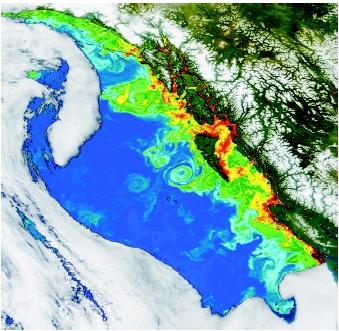Ocean Mixing
Mixing in the ocean occurs on several scales, the smallest scale being molecular. If a layer of warm, salty water lies above a layer of colder, fresher water, the heat and salt will tend to diffuse (spread out) downwards to make a single layer with intermediate temperature and salinity values. However, because heat diffuses faster than salt, the process can lead to local instabilities in the density structure which cause mixing within a layer many meters thick. The best-known example of this process, known as salt fingering, occurs where very salty water from the Mediterranean outflow mixes into the North Atlantic.

Most mixing, however, takes place on larger scales in response to forcing by the wind (in the upper layers), by tides (particularly close to shore or in confined areas or those with rough topography), or by currents. Mixing by winds and tides often results in a surface mixed layer having homogeneous temperature and salinity. This layer may be separated from the water below it by a jump in temperature or salinity, known as a thermocline or pycnocline, respectively. *
Flow in the ocean is not smooth but turbulent, and this increases mixing at the edge of currents by causing eddies to form. Such turbulent mixing can often be seen in rivers immediately downstream of bridges, where the fast water flow is affected by the bridge piers.
Currents and Eddies
Because ocean currents are many kilometers wide, they have a correspondingly large effect on mixing in the oceans. As may be expected from the positions of ocean currents, most mixing in the upper layers of the ocean takes place on the western boundaries of ocean gyres where the current speeds are greatest. Considerable mixing also occurs along the fronts which border the Antarctic Circumpolar Current. The mixing is evident in temperature or color images of the sea surface because the edge of the current is drawn out into filaments (strands), which mix into the quieter waters outside the current.
Frequently, discrete parcels of water break off from the current as eddies, which may be up to about 200 kilometers (125 miles) across and last for many months. They drift across ocean basins at speeds of about 5 centimeters per second, which is equivalent to 4.3 kilometers (2.5 miles) per day, or roughly 0.2 kilometer (0.1 mile) per hour. In comparison, atmospheric eddies (tropical cyclones) are larger (up to 2,000 kilometers [1,250 miles] across) and move faster (up to 30 kilometers [18 miles] per hour). Depending on their source, oceanic eddies may contain water either warmer or colder than that into which they mix, or of very different salinity, as occurs where water from the Mediterranean mixes into the North Atlantic.
As the eddies revolve they lose water through mixing into their surroundings. This occurs most rapidly along surfaces of equal density, which tend to be almost flat in the ocean, so the mixing is generally horizontal rather than vertical. Vertical mixing occurs only in a few places, such as zones of divergence, or upwelling, along the eastern boundaries of oceans and near the equator. It occurs also in the Arctic and Antarctic where the freezing of water during the winter causes dense brines to be produced. As they sink, they cause additional mixing within the water column.
SEE ALSO Ocean Currents ; Oceanography from Space ; Oceanography, Physical ; Sea Water, Physics and Chemistry of .
Piers Chapman
Bibliography
Open University Course Team. Ocean Circulation. Oxford, U.K.: Pergamon Press, 1989.
Pond, Stephen, and George L. Pickard. Introductory Dynamical Oceanography. Oxford, U.K.: Pergamon Press, 1983.
* See "Sea Water, Physics and Chemistry of" for a depth profile illustrating a thermocline and pycnocline.
Comment about this article, ask questions, or add new information about this topic: